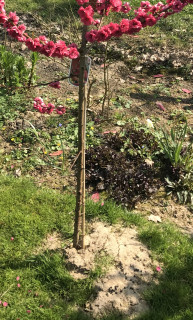Young peach tree with nanoclay grows 4x faster in a month.
Amsterdam garden clay soil, water, sun, offers 10-20 sqm CO2 absorption and juicy peaches in a few years 🤗
First Peach tree with nano tech


Young peach tree with nanoclay grows 4x faster in a month.
Amsterdam garden clay soil, water, sun, offers 10-20 sqm CO2 absorption and juicy peaches in a few years 🤗
Get notified about new updates, opportunities or events that match your interests.

The pioneering innovations were presented of the Scale Up Future-proof artificial turf pitches project, a collaboration between Amsterdam and Haarlem focused on sustainable artificial turf pitches. Over the next few years, more than 250 sports pitches in both cities will be transformed into circular, energy-generating and climate-adaptive sports venues. These artificial turf pitches can not only generate and store energy, but also involve smart water management. An approach that is globally relevant for urban sports infrastructure.
Three consortia collaborate on the sport pitch of the future
The three selected consortia Antea Sport, EnergieVeld and GOO4iT together comprise more than 15 market players. They join forces within this innovation partnership, where there is room for long-term collaboration, co-creation and scalable innovation. The pioneering solutions will make it possible to cool down sport pitches on warm days, help dispose of and collect rainwater, make the pitches more pleasant for the users and possibly even generate energy for the surrounding area. Find out how these innovations are shaping the sport pitch of the future here.
Two municipalities: joint procurement
The Scale Up Future-proof artificial turf pitches project is a unique collaboration between two municipalities and market players. The municipalities jointly procure pooling their purchasing power and use an innovation partnership to challenge the market to test and scale up innovative and sustainable solutions. In doing so, the solutions are also scalable and transferable to other cities in the Netherlands and Europe.
From prototype to pilot fields
The first prototype fields will be constructed in Amsterdam and Haarlem in 2026, in different capacities and combining multiple innovations, where they will be extensively tested and monitored for a year. Successful concepts are then scaled up to full-scale pilot pitches and tested and monitored for another year. This will form the basis for the new standard of sustainable sports pitches, with potential for adoption in other cities around the world. At the same time, existing pitches are already being improved with the most sustainable solutions available, making an immediate impact from the start. The project thus shows how cooperation between municipalities and market players can lead to innovative, climate-proof sports infrastructure with international relevance.
Join us
This project provides cities worldwide a blueprint for sustainable, smart, and future-proof artificial turf pitches. Interested municipalities and industry partners can get in touch and subscribe to our news updates by sending an e-mail to: sportveldvandetoekomst@amsterdam.nl.

Learn with the case study Amsterdam to anticipate future food disruptions. Understand the city's food supply chain vulnerabilities is critical for enhancing food resilience. Enhance food resilience in empowerment of people in urban food growing.

How can citizens reclaim transparency in a world increasingly shaped by networked safety and enforcement cameras? Join our ThingsCon workshop to explore the power of sousveillance—using the tools of surveillance to scrutinize the systems that watch us.
Networked safety and enforcement cameras increasingly shape urban life, yet their presence and function often remain opaque. This workshop explores how citizens can turn the tools of surveillance back onto the systems that watch them: Redirecting object recognition to identify street camera's for civic scrutiny. Building on several camera spotting tours supported with various versions of a “mobile transparency app”, we introduce a new prototype that uses object recognition to detect street cameras and log them through a civic annotation workflow.
The workshop is for anyone interested in civic tech, democratic oversight, and human-scale alternatives to opaque “smart city” systems. Together, we explore how civic sousveillance might evolve into a deeper practice of scrutinizing—and reshaping—the technologies embedded in our streets.
More info and tickets: https://thingscon.org/events/things-2025
More info on the Human Values for Smarter Cities research project we are conducting: https://humanvaluesforsmartercities.nl/


Hup Holland! http://www.elementalwatermakers.com/projects
www.youtube.com/watch?v=w04PWoMTab8
yes true, that is being researched, we are going to get help with an University for water and electricity sourcing
Elsewhere, I invited agro-scientist to evaluate this amazing development. Personally, I am afraid that the availability of a large and steady supply of unsalted water is critical